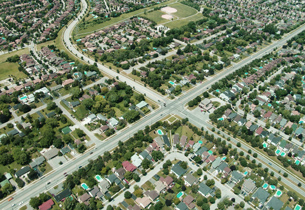Module 8
1. Module 8
1.32. Page 2
Module 8—Populations, Individuals, and Gene Pools
 Explore
Explore

© filtv/6880678/Fotolia
Determining Population Growth
Looking at the rate at which Canada’s natural landscape is being converted to residential housing might convince you that the Canadian population is growing rapidly, but is this true? What factors cause populations to increase, or decrease, in size?
In your social studies curriculum you’ve likely learned that the Canadian population is indeed growing. You know that Canadians are living longer—the rate of death (mortality) has fallen due to good health care, nutrition, and a high standard of living. With a growing Canadian population, you would expect the birth rate (natality) to be high, but your studies have likely shown you that Canadian birth rates are, in fact, quite low. Low birth rates are considered to be an economic problem because, in future years, the size of the work force will not be large enough to maintain a thriving economy—especially with the large number of retiring baby boomers. If birth rates are low, how can the population still be growing?
The answer is immigration. Like all open populations, individuals in Canada come and go—some immigrate to Canada to find work or build a new life while others emigrate to other countries. In Canada there is a strong immigration policy intended to build a work force that has been depleted by low birth rates.
Common descriptors for population studies include the following:
- Population size (N). There are four determiners: births (natality), deaths (mortality), immigration, and emigration.
- Natality and immigration. These increase population size.
- Mortality and emigration. These decrease population size.
- Change in population size or population growth. Consider the formula (DN) = (natality + immigration) – (mortality + emigration)
mortality: number of deaths; due to starvation (competition), predation, or disease
natality: number of births; tends to increase with food supply and decrease with competition
immigration: number of individuals entering the population from outside; can be due to abiotic factors (e.g., escape from fire, drought, flood, climate change) or biotic factors (e.g., increased competition)
emigration: number of individuals that leave the population; due to the same reasons as immigration
 Read
Read
Your study of population growth and interactions will involve math and graphing. Remember that practising these skills is essential to your success. Read from “Population Growth” on page 707 of the textbook to the end of “Carrying Capacity” on page 712 in your textbook. Study the examples carefully and summarize this information for your course folder.
 Self-Check
Self-Check
To get practice in using your formula for population growth (DN), try the following questions and check your work.
SC 1. A breeding flock of trumpeter swans near Grande Prairie is made up of 50 pairs. This year there were 165 live hatchlings, no new birds joined the flock, five animals were shot, and eight did not return this spring from their southern migration.
Determine quantitatively how the population of trumpeter swans has changed.
SC 2.
- ΔN of a hypothetical wild elk population is dropping. Suggest four reasons why this might be the case.
-
population determiners: four factors that change the numbers of individuals in the population: natality, mortality, immigration, and emigrationThe elk habitat referred to in part a was being developed for oil and gas exploration. Biologists observed that elk were unwilling to cross the many secondary roads that were being built to support the petroleum industry. Explain, using the four population determiners, how growth of the elk population would be affected.
 Self-Check Answers
Self-Check Answers
SC 1.
ΔN = (natality + immigration) − (mortality + emigration)
ΔN = (165 + 0) − (5 + 8) = 152
SC 2.
a. DN is population growth.
ΔN = (natality + immigration) – (mortality + emigration). Therefore, the drop in ΔN could be due to the following:
- decreased birth rate
- increased death rate
- decreased immigration
- increased emigration
b. If the elk won’t cross roads, this will interfere with their normal movements to find food, water, and mates, thus decreasing the size of their habitat. Natality will likely fall and mortality will likely rise. Immigration will be prevented (reducing population size), but emigration may also be prevented (increasing population size). If this population usually undergoes a yearly migration to breeding or feeding grounds, then restricting its movement in this way will definitely cause ΔN to drop.
 Try This
Try This
To practise the concepts you have learned, complete the “4.11 Population Size” drag-and-drop activity. Click on the link, and then select the activity from the menu on the left.
 Reflect and Connect
Reflect and Connect
The goal of wildlife management is to keep the size of wild populations at desirable levels. Wildlife managers protect wildlife populations from external influences and control population size by altering food supply, habitat, density of predators, and prevalence of disease. If population sizes exceed what the habitat can sustain, wildlife managers are responsible for setting hunting “bag” limits. In the Module 8: Lesson 8 Assignment you will look at the job of wildlife management using your knowledge of determiners of population size.
 Module 8: Lesson 8 Assignment
Module 8: Lesson 8 Assignment
Retrieve your copy of the Module 8: Lesson 8 Assignment that you saved to your computer earlier in this lesson. Complete the assignment. Save your completed assignment in your course folder. Submit your completed Module 8: Lesson 8 Assignment to your teacher for assessment.